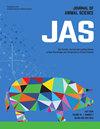Beef cattle phenotypic plasticity and stability of dry matter intake and respiration rate across varying levels of temperature humidity index
IF 2.7
2区 农林科学
Q1 AGRICULTURE, DAIRY & ANIMAL SCIENCE
引用次数: 0
Abstract
Expected changes in climate warrant research on selection for a phenotypically stable cattle population that can perform consistently across diverse environmental conditions. In this study, we utilize a heteroscedastic random regression model to: 1) characterize the additive genetic and other phenotypic components of dry matter intake (DMI) and respiration rate (RR) with respect to the temperature humidity index (THI), 2) assess the presence of genotype-by-environment interactions (G×E) by determining whether the additive genetic reaction norm changes along the observed THI range and by evaluating the additive genetic correlations between DMI or RR at different THI values, and 3) evaluate model derived accuracy of estimated breeding values (EBV) along a range of THI. Data consisted of repeated observations of DMI and RR on 788 and 569 steers, respectively, over a period of 70d. A hierarchical model with subject-specific additive genetic and permanent environment effects was fitted to each trait using Bayesian inference. Estimated population slopes, expressed as posterior median and 95% highest posterior density (HPD) interval, were -0.046 (-0.053, -0.039) kg DMI per unit increase in THI per day and 0.027 (0.026, 0.029) breaths per 30s (BP30S) RR for each unit increase in THI on the logarithmic scale, thereby suggesting environmental sensitivity for both traits. Estimated correlations between the additive genetic intercept and slope were -0.78 (-0.86, -0.69) and -0.66 (-1.0, -0.20) for DMI and RR, respectively, indicating that selection for increased DMI and decreased RR at the onset of heat stress can be expected to associate positively with mean population environmental sensitivity to THI. Heritability estimates for DMI at the onset of heat stress (i.e., THI of 70) ranged from 0.30 (0.17, 0.44) to 0.37 (0.20, 0.48) across cohorts, but decreased as THI increased. Heritability estimates for RR were low, with 95% HPD upper boundaries ranging from 0.03 to 0.08 across the range of THI evaluated. For DMI, the median additive genetic correlation between 70 and 85 THI and the Spearman correlations between estimated breeding values at 70 and 85 THI levels were 0.42 (0.26, 0.57) and 0.39 (0.26, 0.52), respectively, indicating substantial G×E. The median DMI EBV model derived accuracy at a specific THI value increased from 70 THI to 0.65 at 82 THI, at which point it stabilized. This was likely because more data points were gathered at greater THI.求助全文
约1分钟内获得全文
求助全文
来源期刊

Journal of animal science
农林科学-奶制品与动物科学
CiteScore
4.80
自引率
12.10%
发文量
1589
审稿时长
3 months
期刊介绍:
The Journal of Animal Science (JAS) is the premier journal for animal science and serves as the leading source of new knowledge and perspective in this area. JAS publishes more than 500 fully reviewed research articles, invited reviews, technical notes, and letters to the editor each year.
Articles published in JAS encompass a broad range of research topics in animal production and fundamental aspects of genetics, nutrition, physiology, and preparation and utilization of animal products. Articles typically report research with beef cattle, companion animals, goats, horses, pigs, and sheep; however, studies involving other farm animals, aquatic and wildlife species, and laboratory animal species that address fundamental questions related to livestock and companion animal biology will be considered for publication.
 求助内容:
求助内容: 应助结果提醒方式:
应助结果提醒方式:


